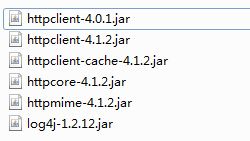HTTP POST接口 发送数据工具类
废话不多说了 直接贴图,贴代码。
希望能帮助给位。。。。。。
以下是我们需要准备的jar包:
下面就是通过HTTP POST接口 发送报文的工具类:
import java.io.BufferedReader;
import java.io.IOException;
import java.io.InputStream;
import java.io.InputStreamReader;
import java.io.OutputStream;
import java.net.HttpURLConnection;
import java.net.URL;
import java.security.cert.CertificateException;
import java.security.cert.X509Certificate;
import java.util.ArrayList;
import java.util.List;
import java.util.Map;
import javax.net.ssl.SSLContext;
import javax.net.ssl.TrustManager;
import javax.net.ssl.X509TrustManager;
import org.apache.http.HttpEntity;
import org.apache.http.HttpResponse;
import org.apache.http.NameValuePair;
import org.apache.http.ParseException;
import org.apache.http.client.ClientProtocolException;
import org.apache.http.client.HttpClient;
import org.apache.http.client.entity.UrlEncodedFormEntity;
import org.apache.http.client.methods.HttpGet;
import org.apache.http.client.methods.HttpPost;
import org.apache.http.client.utils.URLEncodedUtils;
import org.apache.http.conn.scheme.Scheme;
import org.apache.http.conn.ssl.SSLSocketFactory;
import org.apache.http.entity.StringEntity;
import org.apache.http.impl.client.DefaultHttpClient;
import org.apache.http.message.BasicNameValuePair;
import org.apache.http.params.CoreConnectionPNames;
import org.apache.http.protocol.HTTP;
import org.apache.http.util.EntityUtils;
import org.apache.log4j.Logger;
public class HttpUtil {
private static Logger logger = Logger.getLogger(HttpUtil.class);
private static String METHOD = "POST";
private static int TIMEOUT = 30000;
private static final String ENCODE = "UTF-8";
/**
* 发送HTTP_GET请求
* @see 该方法会自动关闭连接,释放资源
* @param requestURL 请求地址(含参数)
* @param decodeCharset 解码字符集,解析响应数据时用之,其为null时默认采用UTF-8解码
* @return 远程主机响应正文
*/
public static String sendGetRequest(String reqURL, String decodeCharset){
long responseLength = 0; //响应长度
String responseContent = null; //响应内容
HttpClient httpClient = new DefaultHttpClient(); //创建默认的httpClient实例
httpClient.getParams().setParameter(CoreConnectionPNames.CONNECTION_TIMEOUT, TIMEOUT);
httpClient.getParams().setParameter(CoreConnectionPNames.SO_TIMEOUT, TIMEOUT);
HttpGet httpGet = new HttpGet(reqURL); //创建org.apache.http.client.methods.HttpGet
try{
HttpResponse response = httpClient.execute(httpGet); //执行GET请求
HttpEntity entity = response.getEntity(); //获取响应实体
if(null != entity){
responseLength = entity.getContentLength();
responseContent = EntityUtils.toString(entity, decodeCharset==null ? "UTF-8" : decodeCharset);
EntityUtils.consume(entity); //Consume response content
}
}catch(ClientProtocolException e){
logger.error("该异常通常是协议错误导致,比如构造HttpGet对象时传入的协议不对(将'http'写成'htp')或者服务器端返回的内容不符合HTTP协议要求等,堆栈信息如下", e);
}catch(ParseException e){
logger.error(e.getMessage(), e);
}catch(IOException e){
logger.error("该异常通常是网络原因引起的,如HTTP服务器未启动等,堆栈信息如下", e);
}finally{
httpClient.getConnectionManager().shutdown(); //关闭连接,释放资源
}
return responseContent;
}
/**
* 发送HTTP_POST请求
* @see 该方法为sendPostRequest(String,String,boolean,String,String)的简化方法
* @see 该方法在对请求数据的编码和响应数据的解码时,所采用的字符集均为UTF-8
* @see 当isEncoder=true时,其会自动对sendData中的[中文][|][ ]等特殊字符进行URLEncoder.encode(string,"UTF-8")
* @param isEncoder 用于指明请求数据是否需要UTF-8编码,true为需要
*/
public static String sendPostRequest(String reqURL, String sendData, boolean isEncoder){
return sendPostRequest(reqURL, sendData, isEncoder, null, null);
}
/**
* 发送HTTP_POST请求
* @see 该方法会自动关闭连接,释放资源
* @see 当isEncoder=true时,其会自动对sendData中的[中文][|][ ]等特殊字符进行URLEncoder.encode(string,encodeCharset)
* @param reqURL 请求地址
* @param sendData 请求参数,若有多个参数则应拼接成param11=value11¶m22=value22¶m33=value33的形式后,传入该参数中
* @param isEncoder 请求数据是否需要encodeCharset编码,true为需要
* @param encodeCharset 编码字符集,编码请求数据时用之,其为null时默认采用UTF-8解码
* @param decodeCharset 解码字符集,解析响应数据时用之,其为null时默认采用UTF-8解码
* @return 远程主机响应正文
*/
public static String sendPostRequest(String reqURL, String sendData, boolean isEncoder, String encodeCharset, String decodeCharset){
String responseContent = null;
HttpClient httpClient = new DefaultHttpClient();
httpClient.getParams().setParameter(CoreConnectionPNames.CONNECTION_TIMEOUT, TIMEOUT);
httpClient.getParams().setParameter(CoreConnectionPNames.SO_TIMEOUT, TIMEOUT);
HttpPost httpPost = new HttpPost(reqURL);
//httpPost.setHeader(HTTP.CONTENT_TYPE, "application/x-www-form-urlencoded; charset=UTF-8");
httpPost.setHeader(HTTP.CONTENT_TYPE, "application/x-www-form-urlencoded");
try{
if(isEncoder){
List
for(String str : sendData.split("&")){
formParams.add(new BasicNameValuePair(str.substring(0,str.indexOf("=")), str.substring(str.indexOf("=")+1)));
}
httpPost.setEntity(new StringEntity(URLEncodedUtils.format(formParams, encodeCharset==null ? "UTF-8" : encodeCharset)));
}else{
httpPost.setEntity(new StringEntity(sendData));
}
HttpResponse response = httpClient.execute(httpPost);
HttpEntity entity = response.getEntity();
if (null != entity) {
responseContent = EntityUtils.toString(entity, decodeCharset==null ? "UTF-8" : decodeCharset);
EntityUtils.consume(entity);
}
}catch(Exception e){
logger.error("与[" + reqURL + "]通信过程中发生异常,堆栈信息如下", e);
}finally{
httpClient.getConnectionManager().shutdown();
}
return responseContent;
}
/**
* 发送HTTP_POST请求
* @see 该方法会自动关闭连接,释放资源
* @see 该方法会自动对params中的[中文][|][ ]等特殊字符进行URLEncoder.encode(string,encodeCharset)
* @param reqURL 请求地址
* @param params 请求参数
* @param encodeCharset 编码字符集,编码请求数据时用之,其为null时默认采用UTF-8解码
* @param decodeCharset 解码字符集,解析响应数据时用之,其为null时默认采用UTF-8解码
* @return 远程主机响应正文
*/
public static String sendPostRequest(String reqURL, Map
String responseContent = null;
HttpClient httpClient = new DefaultHttpClient();
httpClient.getParams().setParameter(CoreConnectionPNames.CONNECTION_TIMEOUT, TIMEOUT);
httpClient.getParams().setParameter(CoreConnectionPNames.SO_TIMEOUT, TIMEOUT);
HttpPost httpPost = new HttpPost(reqURL);
List
for(Map.Entry
formParams.add(new BasicNameValuePair(entry.getKey(), entry.getValue()));
}
try{
httpPost.setEntity(new UrlEncodedFormEntity(formParams, encodeCharset==null ? "UTF-8" : encodeCharset));
HttpResponse response = httpClient.execute(httpPost);
HttpEntity entity = response.getEntity();
if (null != entity) {
responseContent = EntityUtils.toString(entity, decodeCharset==null ? "UTF-8" : decodeCharset);
EntityUtils.consume(entity);
}
}catch(Exception e){
logger.error("与[" + reqURL + "]通信过程中发生异常,堆栈信息如下", e);
}finally{
httpClient.getConnectionManager().shutdown();
}
return responseContent;
}
/**
* 发送HTTPS_POST请求
* @see 该方法为sendPostSSLRequest(String,Map方法的简化方法
* @see 该方法在对请求数据的编码和响应数据的解码时,所采用的字符集均为UTF-8
* @see 该方法会自动对params中的[中文][|][ ]等特殊字符进行URLEncoder.encode(string,"UTF-8")
*/
public static String sendPostSSLRequest(String reqURL, Map
return sendPostSSLRequest(reqURL, params, null, null);
}
/**
* 发送HTTPS_POST请求
* @see 该方法会自动关闭连接,释放资源
* @see 该方法会自动对params中的[中文][|][ ]等特殊字符进行URLEncoder.encode(string,encodeCharset)
* @param reqURL 请求地址
* @param params 请求参数
* @param encodeCharset 编码字符集,编码请求数据时用之,其为null时默认采用UTF-8解码
* @param decodeCharset 解码字符集,解析响应数据时用之,其为null时默认采用UTF-8解码
* @return 远程主机响应正文
*/
public static String sendPostSSLRequest(String reqURL, Map
String responseContent = "";
HttpClient httpClient = new DefaultHttpClient();
httpClient.getParams().setParameter(CoreConnectionPNames.CONNECTION_TIMEOUT, TIMEOUT);
httpClient.getParams().setParameter(CoreConnectionPNames.SO_TIMEOUT, TIMEOUT);
X509TrustManager xtm = new X509TrustManager(){
public void checkClientTrusted(X509Certificate[] chain, String authType) throws CertificateException {}
public void checkServerTrusted(X509Certificate[] chain, String authType) throws CertificateException {}
public X509Certificate[] getAcceptedIssuers() {return null;}
};
try {
SSLContext ctx = SSLContext.getInstance("TLS");
ctx.init(null, new TrustManager[]{xtm}, null);
SSLSocketFactory socketFactory = new SSLSocketFactory(ctx);
httpClient.getConnectionManager().getSchemeRegistry().register(new Scheme("https", socketFactory, 443));
HttpPost httpPost = new HttpPost(reqURL);
List
for(Map.Entry
formParams.add(new BasicNameValuePair(entry.getKey(), entry.getValue()));
}
httpPost.setEntity(new UrlEncodedFormEntity(formParams, encodeCharset==null ? "UTF-8" : encodeCharset));
HttpResponse response = httpClient.execute(httpPost);
HttpEntity entity = response.getEntity();
if (null != entity) {
responseContent = EntityUtils.toString(entity, decodeCharset==null ? "UTF-8" : decodeCharset);
EntityUtils.consume(entity);
}
} catch (Exception e) {
logger.error("与[" + reqURL + "]通信过程中发生异常,堆栈信息为", e);
} finally {
httpClient.getConnectionManager().shutdown();
}
return responseContent;
}
/**
* 发送HTTP_POST请求
* @see 若发送的params中含有中文,记得按照双方约定的字符集将中文URLEncoder.encode(string,encodeCharset)
* @see 本方法默认的连接超时时间为30秒,默认的读取超时时间为30秒
* @param reqURL 请求地址
* @param params 发送到远程主机的正文数据,其数据类型为java.util.Map
* @return 远程主机响应正文`HTTP状态码,如"SUCCESS`200"
若通信过程中发生异常则返回"Failed`HTTP状态码",如"Failed`500"
*/
public static String sendPostRequestByHUC(String reqURL, Map
StringBuilder sendData = new StringBuilder();
for(Map.Entry
sendData.append(entry.getKey()).append("=").append(entry.getValue()).append("&");
}
if(sendData.length() > 0){
sendData.setLength(sendData.length() - 1); //删除最后一个&符号
}
return sendPostRequestByHUC(reqURL, sendData.toString());
}
/**
* 发送HTTP_POST请求
* @see 若发送的sendData中含有中文,记得按照双方约定的字符集将中文URLEncoder.encode(string,encodeCharset)
* @see 本方法默认的连接超时时间为30秒,默认的读取超时时间为30秒
* @param reqURL 请求地址
* @param sendData 发送到远程主机的正文数据
* @return 远程主机响应正文`HTTP状态码,如"SUCCESS`200"
若通信过程中发生异常则返回"Failed`HTTP状态码",如"Failed`500"
*/
public static String sendPostRequestByHUC(String reqURL, String sendData){
HttpURLConnection httpURLConnection = null;
BufferedReader br = null;
OutputStream out = null; //写
InputStream in = null; //读
int httpStatusCode = 0; //远程主机响应的HTTP状态码
String result = "";
try{
URL sendUrl = new URL(reqURL);
httpURLConnection = (HttpURLConnection)sendUrl.openConnection();
httpURLConnection.setRequestMethod(METHOD);
httpURLConnection.setDoOutput(true); //指示应用程序要将数据写入URL连接,其值默认为false
httpURLConnection.setUseCaches(false);
httpURLConnection.setConnectTimeout(TIMEOUT); //30秒连接超时
httpURLConnection.setReadTimeout(TIMEOUT); //30秒读取超时
out = httpURLConnection.getOutputStream();
out.write(sendData.toString().getBytes("UTF-8"));
//清空缓冲区,发送数据
out.flush();
//获取HTTP状态码
httpStatusCode = httpURLConnection.getResponseCode();
//接收返回数据
String readLine = "";
StringBuffer sb=new StringBuffer();
br = new BufferedReader(new InputStreamReader(
httpURLConnection.getInputStream(), "UTF-8"));
while((readLine = br.readLine()) != null){
sb.append(readLine);
}
result = sb.toString();
return result;
}catch(Exception e){
logger.error(e.getMessage());
return "Failed`" + httpStatusCode;
}finally{
if(out != null){
try{
out.close();
}catch (Exception e){
logger.error("关闭输出流时发生异常,堆栈信息如下", e);
}
}
if(in != null){
try{
in.close();
}catch(Exception e){
logger.error("关闭输入流时发生异常,堆栈信息如下", e);
}
}
if(httpURLConnection != null){
httpURLConnection.disconnect();
httpURLConnection = null;
}
}
}
}
具体怎么运用我就不作解释,有些地方还是需要我们自己动手的。
